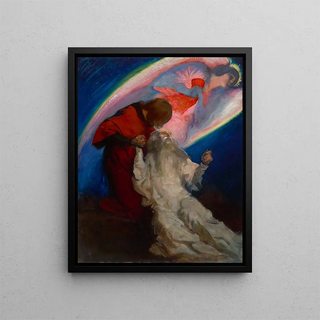Art print | Study for Amfortas published by Galahad in The Quest and the Success of the Holy Grail - Edwin Austin Abbey


View from behind

Frame (optional)
In the vast panorama of art history, certain works stand out for their ability to capture the collective imagination and evoke timeless stories. The art print *Étude pour Amfortas* published by Galahad in *La Quête et la Réussite du Saint Graal* by Edwin Austin Abbey is a perfect example. This piece, imbued with mystery and depth, plunges us into the heart of a legendary quest, that of the Holy Grail, a symbol of purity and transcendence. Through the lens of art, Abbey invites us to explore themes of suffering, redemption, and heroism, while immersing us in a rich and evocative visual universe.
Style and uniqueness of the work
Edwin Austin Abbey's work is distinguished by its unique style, blending realism with a touch of romanticism. The colors, both vivid and nuanced, create an atmosphere that is simultaneously mysterious and captivating. The choice of characters and their staging demonstrate impressive technical mastery, where every detail is carefully thought out to serve the narrative. Amfortas, a tragic figure from Arthurian legend, is depicted in a moment of vulnerability, his expression reflecting deep suffering. Abbey succeeds in capturing this duality between strength and weakness, making the character all the more human and accessible. The composition of the work, both dynamic and balanced, guides the viewer's gaze across the painting, inviting them to discover the subtleties of this epic quest.
The artist and his influence
Edwin Austin Abbey, a 19th-century American artist, is recognized for his ability to merge art and literature. His works, often inspired by mythic and historical stories, reflect a deep admiration for European culture, particularly England. Abbey managed to establish himself on the artistic scene of his time thanks to his innovative vision and keen sense of visual storytelling. His influence extends beyond his creations, inspiring many contemporary artists who see in him a model of artistic commitment.

Matte finish

View from behind

Frame (optional)
In the vast panorama of art history, certain works stand out for their ability to capture the collective imagination and evoke timeless stories. The art print *Étude pour Amfortas* published by Galahad in *La Quête et la Réussite du Saint Graal* by Edwin Austin Abbey is a perfect example. This piece, imbued with mystery and depth, plunges us into the heart of a legendary quest, that of the Holy Grail, a symbol of purity and transcendence. Through the lens of art, Abbey invites us to explore themes of suffering, redemption, and heroism, while immersing us in a rich and evocative visual universe.
Style and uniqueness of the work
Edwin Austin Abbey's work is distinguished by its unique style, blending realism with a touch of romanticism. The colors, both vivid and nuanced, create an atmosphere that is simultaneously mysterious and captivating. The choice of characters and their staging demonstrate impressive technical mastery, where every detail is carefully thought out to serve the narrative. Amfortas, a tragic figure from Arthurian legend, is depicted in a moment of vulnerability, his expression reflecting deep suffering. Abbey succeeds in capturing this duality between strength and weakness, making the character all the more human and accessible. The composition of the work, both dynamic and balanced, guides the viewer's gaze across the painting, inviting them to discover the subtleties of this epic quest.
The artist and his influence
Edwin Austin Abbey, a 19th-century American artist, is recognized for his ability to merge art and literature. His works, often inspired by mythic and historical stories, reflect a deep admiration for European culture, particularly England. Abbey managed to establish himself on the artistic scene of his time thanks to his innovative vision and keen sense of visual storytelling. His influence extends beyond his creations, inspiring many contemporary artists who see in him a model of artistic commitment.






